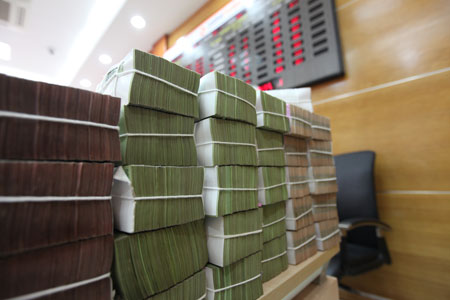Central bank assuages foreign currency lending fears

illustration photo
The rise is in-line with the central bank’s plans, Hong said, explaining that in the context of slow credit growth in the first six months of 2014, the SBV has allowed banks to increase foreign currency lending to boost total credit growth, and thus enhance economic growth.
The growth of foreign currency lending has recently outpaced that of dong lending. According to data by the Ministry of Planning and Investment, lending in foreign currencies as of June 20 had grown by 10.51 per cent since the end of 2013, while credit provided in VND only rose by 0.68 per cent.
The increase in foreign currency lending may put pressure on the system, the National Financial Supervisory Committee (NFSC) recently opined in a report.
Addressing this concern, Hong said that on-year growth is not alarming. Foreign currency lending may have grown by 9.35 per cent since the end of last year, but is only up 1.34 per cent on-year.
Moreover, if foreign currency deposits and other stocks of foreign capital are accounted for, the total lending in foreign currencies only comes to 50-60 per cent of the total supply.
Finally, banks mostly lend foreign currencies to firms that have supplies of foreign currencies, so banks do not have to sell additional foreign currencies to borrowers for repayment. Firms without a foreign currency supply can only take out a foreign currency loan if they belong to a field prioritised by the government.
Hong affirmed the SBV’s persistence to prevent dollarisation of the economy.
She said the SBV expected a stable US dollar-Vietnam dong exchange rate from now to the year-end, and would only devalue the Vietnam dong by a maximum 1 per cent if needed.
What the stars mean:
★ Poor ★ ★ Promising ★★★ Good ★★★★ Very good ★★★★★ Exceptional
Latest News
More News
- The promotion of ESG via banking (November 21, 2024 | 09:32)
- Standard Chartered committed to Vietnam’s financial success (November 21, 2024 | 09:24)
- Full ESG adoption the priority for Agribank (November 21, 2024 | 09:07)
- Banks entice youth with tech advances (November 21, 2024 | 08:00)
- ESG represents a shift towards sustainability for banks (November 20, 2024 | 13:00)
- GGGI supports Vietcombank’s debut of $80 million green bonds (November 20, 2024 | 11:20)
- SHB and the ESG journey: creating social value in every step (November 19, 2024 | 15:00)
- Banking sector contributes to ESG, green growth, and sustainable development (November 19, 2024 | 14:42)
- ESG implementation in banking: from awareness to action (November 19, 2024 | 12:08)
- VIR hosts 'ESG in Banking: Leading Through Implementation' conference (November 19, 2024 | 11:14)




















 Mobile Version
Mobile Version